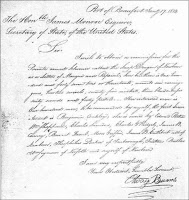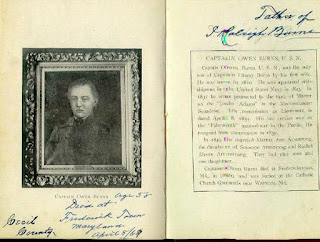 Otway Burns was born about 1785 in Swansboro, NC. He married Joanna Grant (-1814) on July 6, 1809. On December 4, 1814, he married Jane Hall. At the age of 57, he married Jane Smith on February 22, 1842 and moved to Portsmouth, NC, where he died on October 25,1850.
Otway Burns was born about 1785 in Swansboro, NC. He married Joanna Grant (-1814) on July 6, 1809. On December 4, 1814, he married Jane Hall. At the age of 57, he married Jane Smith on February 22, 1842 and moved to Portsmouth, NC, where he died on October 25,1850.
________________________________________
In A Brief Biographical Sketch of the Life and Exploits of Captain Otway Burns Jr., Tucker R. Littleton wrote:
"Captain Otway Burns was born on the west side of the mouth of Queen's Creek (near Swansboro , NC
"At the time that Burns bought the lot, it contained a dwelling house on the portion lying between Front and Water streets, and Capt. Burns and his young wife may have resided for a time on that lot. The lower portion of the lot, lying between Front Street
"It was his role in the War of 1812 that won Burns his fame and made him Onslow County
 |
| SNAP DRAGON Model by Jim Goodwin |
"Following the war, the enterprising Captain Burns returned to his old trade of shipbuilding and eventually at Beaufort tried his hand at storekeeping, salt making, brick making, and investing in the Clubfoot and Harlowe Creek Canal Company. A Democrat in politics, Burns represented Carteret County Yancey County Burnsville
"In 1836, President Andrew Jackson, himself a hero of the War of 1812, appointed Burns keeper of the Brant Shoals Lighthouse at Portsmouth Portsmouth October 25, 1850 . He is buried in the Old Burying Ground in Beaufort.
"Today Swansboro's most famous son has two North Carolina Yancey County Carteret County May 6, 1983 , North Carolina Burnsville
____________________________________
In Captain Otway Burns and His Ship Snap Dragon, historian Jack Robinson wrote:
"Otway Burns was issued a shipbuilding contract from a Wilmington, North Carolina company, Captain James Seawell & Associated, in the year 1818. He was to build the first ship from North Carolina to be powered solely by a steam engine...[he] designed and built his new ship in his Beaufort shipyard. Prometheus was the name given...Announcements were made that he would soon be leaving Beaufort heading for a major reception at the port of Wilmington.
"Burns also built two large vessels--the Warrior in 1823 and the Henry in 1831. These vessels were used to carry cargo from North Carolina to various ports, to include as far away as South Africa and the West Indies.
"Otway Burns was issued a shipbuilding contract from a Wilmington, North Carolina company, Captain James Seawell & Associated, in the year 1818. He was to build the first ship from North Carolina to be powered solely by a steam engine...[he] designed and built his new ship in his Beaufort shipyard. Prometheus was the name given...Announcements were made that he would soon be leaving Beaufort heading for a major reception at the port of Wilmington.
"Burns also built two large vessels--the Warrior in 1823 and the Henry in 1831. These vessels were used to carry cargo from North Carolina to various ports, to include as far away as South Africa and the West Indies.
"The shipyard of Otway Burns was known for quality and workmanship of the vessels that were built there. After building the last of the two Brigs, little is known about additional construction at the shipyard. Captain Burns constructed a personal vessel for himself.
"Possibly out of the loss of Snap Dragon during the War of 1812, Captain Burns built himself another vessel and also named it Snap Dragon. This ship was sleek and known to have been very fast. He also built into the construction of this vessel the first-known 'center-board' used in the waters of North Carolina North Carolina
In Jack Robinson's book, Captain Otway Burns and his ship Snap Dragon, he also included an 1814 request of marque and reprisal written from Beaufort, where Burns made his home and built a shipyard.
Thus Prometheus was built in 1818 in Beaufort, not in Swansboro as claimed.
 |
| Prometheus |
 |
| 1814 Letter from Burns |
Thus Prometheus was built in 1818 in Beaufort, not in Swansboro as claimed.
_______________________________________
When established, October 2, 1713, Beaufort contained about 100 acres. To meet the requirements of a township, when incorporated in 1723, Beaufort was increased to 200 acres.
The marker "indicates the dividing line between Old & New Town and was erected in place of a cannon which formerly stood here; said cannon being part of the armament of the U.S. Privateer Snap Dragon commanded by Cap't Otway Burns in the War of 1812-15."
The Old Burying Ground cannon monument was erected by Burns' descendants. The unveiling took place July 24, 1901. Chief Justice Walter Clark was orator.

 |
| Walter Francis Burns' 1905 book online |
Grandson Walter Francis Burns wrote:
"Captain Otway Burns married in 1809 a Miss Grant, daughter of Reuben Grant of Onslow County. By his marriage he had one child, Owen Burns, born in 1810, who became a lieutenant in the United States Navy. After the death of his first wife, he married December 4, 1814, Miss Jane Hall of Beaufort and for her a handsome residence was built in Beaufort near the spot where the Atlantic House Hotel afterwards stood; he resided there for twenty-two years. Burns' shipyard was in Beaufort. After Jane's death, he married Miss Jane Smith of Smyrna, N.C., on February 22nd, 1842, and moved to Portsmouth, N.C., where he lived until his death." (Captain Otway Burns - Patriot, Privateer and Legislator, Walter Francis Burns, New York, 1905)
_____________________________________
SYNOPSIS OF FAMILY
 Burns' connection to Beaufort's Old Town-New Town Boundary Marker - Northwest corner of Front and Pollock Streets
Burns' connection to Beaufort's Old Town-New Town Boundary Marker - Northwest corner of Front and Pollock Streets
SYNOPSIS OF FAMILY
FRANCIS BURNS, the immigrant, was born about 1710 in Glasgow, Lanarkshire, Scotland. He settled in the Onslow County area of North Carolina in 1734 and died about 1793. Francis and his wife Mary Otway had five sons: Otway (the father of Captain Otway Burns), Richard, Joseph, Frederick, and Jesse.
OTWAY BURNS SR., the elder, born about 1750, and unknown spouse were parents of Mary Ann Burns (born about 1780) and Otway Burns (1785-1850), both born in Swansboro, Onslow County on the family homestead overlooking Bogue Sound, near Queens Creek. On January 28, 1798, Mary Ann married John Sanders in Onslow County; they were parents of John, Otway Burns, and Eli Walter Sanders.
Captain OTWAY BURNS was born about 1785 on the Onslow County family plantation. On July 6, 1809, he first married Joanna Grant (-1814). Their only son OWEN BURNS was born in 1810. In 1814, Joanna left Otway Burns, with son Owen; she died that same year, leaving her young son with family for five years before Burns obtained legal guardianship of Owen. Owen served in the US Navy from 1834 until 1840. On November 18, 1849, their 39-year-old son Owen married 15-year-old Martha Ann Armstrong (1834-1913) of Baltimore.
On December 2, 1814, Captain Otway Burns' second marriage was to 18-year-old Jane Hall. They had one daughter, HARRIET HALL BURNS (1827-1882), who married Richard Cornelius Canaday on February 21, 1844.
OF NOTE: Descendants of Owen Burns have always denied that Owen had a half-sister Harriet Hall Burns. It is said that Owen hated his younger sister so much that when Otway went to sea, he arranged for her to stay in Onslow with the Canaday family. Harriet was raised by Cornelius Canaday and his wife Jane Bell, and ended up marrying their son Richard.
On February 22, 1842, after Jane Hall's death, Captain Burns married Jane Smith (1794-1859) of Smyrna, and moved to Portsmouth, N.C. where he lived until his death, October 25, 1850.
_____________________________________ OTWAY BURNS SR., the elder, born about 1750, and unknown spouse were parents of Mary Ann Burns (born about 1780) and Otway Burns (1785-1850), both born in Swansboro, Onslow County on the family homestead overlooking Bogue Sound, near Queens Creek. On January 28, 1798, Mary Ann married John Sanders in Onslow County; they were parents of John, Otway Burns, and Eli Walter Sanders.
Captain OTWAY BURNS was born about 1785 on the Onslow County family plantation. On July 6, 1809, he first married Joanna Grant (-1814). Their only son OWEN BURNS was born in 1810. In 1814, Joanna left Otway Burns, with son Owen; she died that same year, leaving her young son with family for five years before Burns obtained legal guardianship of Owen. Owen served in the US Navy from 1834 until 1840. On November 18, 1849, their 39-year-old son Owen married 15-year-old Martha Ann Armstrong (1834-1913) of Baltimore.
On December 2, 1814, Captain Otway Burns' second marriage was to 18-year-old Jane Hall. They had one daughter, HARRIET HALL BURNS (1827-1882), who married Richard Cornelius Canaday on February 21, 1844.
OF NOTE: Descendants of Owen Burns have always denied that Owen had a half-sister Harriet Hall Burns. It is said that Owen hated his younger sister so much that when Otway went to sea, he arranged for her to stay in Onslow with the Canaday family. Harriet was raised by Cornelius Canaday and his wife Jane Bell, and ended up marrying their son Richard.
On February 22, 1842, after Jane Hall's death, Captain Burns married Jane Smith (1794-1859) of Smyrna, and moved to Portsmouth, N.C. where he lived until his death, October 25, 1850.
 Burns' connection to Beaufort's Old Town-New Town Boundary Marker - Northwest corner of Front and Pollock Streets
Burns' connection to Beaufort's Old Town-New Town Boundary Marker - Northwest corner of Front and Pollock StreetsWhen established, October 2, 1713, Beaufort contained about 100 acres. To meet the requirements of a township, when incorporated in 1723, Beaufort was increased to 200 acres.
The marker "indicates the dividing line between Old & New Town and was erected in place of a cannon which formerly stood here; said cannon being part of the armament of the U.S. Privateer Snap Dragon commanded by Cap't Otway Burns in the War of 1812-15."
The Old Burying Ground cannon monument was erected by Burns' descendants. The unveiling took place July 24, 1901. Chief Justice Walter Clark was orator.




